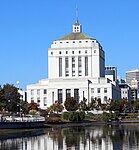Laney College Football Stadium
Alameda County, California building and structure stubsBuildings and structures in Oakland, CaliforniaCalifornia sports venue stubsFormer National Independent Soccer Association stadiumsHigh school football venues in California ... and 5 more
History of Oakland, CaliforniaLaney CollegeSoccer venues in CaliforniaSports venues in Oakland, CaliforniaUSL Championship stadiums
Laney College Football Stadium is a multi-purpose stadium located on the Laney College campus in Oakland, California on the former site of Frank Youell Field. It is owned and operated by Laney College and is the home field of the Laney Eagles track & field and football teams. It is also the home field of the Oakland Roots SC soccer team of the USL Championship. For Roots games, the pitch is widened using a modular turf system. The stadium has room for 3,500 seated and up to 5,500+ with standing room.
Excerpt from the Wikipedia article Laney College Football Stadium (License: CC BY-SA 3.0, Authors).Laney College Football Stadium
Fallon Street, Oakland
Geographical coordinates (GPS) Address Nearby Places Show on map
Geographical coordinates (GPS)
| Latitude | Longitude |
|---|---|
| N 37.7945 ° | E -122.2587 ° |
Address
Laney College
Fallon Street 900
94607 Oakland
California, United States
Open on Google Maps





